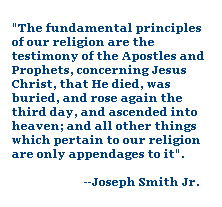Measure the Pattern of the Temple
Ezek. 43: 10 Thou son of man, shew the house to the house of Israel, that they may be ashamed of their iniquities: and let them measure the pattern.
God shows us the purpose of the temple in Ezek 43:10. Here God is showing Ezekiel a large Old Testament, Aaronic Priesthood, Law of Moses type temple and asks Ezekiel to "measure the pattern." Ezekiel is told to make careful notice of the form, function, fashion, and ordinances of the temple. Why? Because the temple is a model and pattern. In this case, the OT temple was to make Israel ashamed and remind them of their unworthiness and need for a Messiah.
LDS, New Testament, Everlasting Covenant, Melchizedek Priesthood Temples work in the same way. Like the OT temples, they point to Christ, but they are of a different model and pattern. Instead of just pointing to our unworthiness before God and need for a Savior, the NT temple also promises sanctification and teaches how sanctification through Christ can be possible in Christ.
Unfortunately, many outsiders and even LDS insiders have an unfortunate misunderstanding of the message of the NT Temple. Unfortunately, some believe that LDS think that by going through the ritual of the temple that that some how guarantees salvation or a greater reward in heaven. Many think that the temple is somehow evidence that LDS believe we can save ourselves or that the grace of Christ is not fully sufficient.
This is not what the temple is about at all. Yes, LDS feel that God has given the NT temple as a gift of His grace to draw us to Christ and therefore it is necessary to receive any gift of grace from God. We are commanded to live by every word that proceedeth forth from the mouth of God and this includes never refusing any of God's gifts of grace. However, like Ezekiel's OT temple, the LDS NT temple and everything that is done within the temple is symbolic. Therefore, it is not the ritual itself that guarantees anything, but what the symbols represent. And it is the acceptance of these truth's that gives us a hope of a greater reward in heaven (1 Cor. 12: 31, Matt. 6: 20, Heb. 11: 35).
So, what does the temple symbolize?
1. The temple points first and foremost to Christ. Only though Christ can anyone hope to return to the presence of the Father.
2. The temple presents God's plan of salvation. The temple presents the fall of Adam and Eve in the Garden of Eden and how God commanded that angels with flaming swords guard the way of the tree of life.
3. The temple teaches how a person through Christ can be empowered to pass by the angels and partake of the tree of life again and dwell in the presence of the Father. Remember in Revelation that it says that to those who overcome, Christ would confess their name before the Father and the angels. What angels? Why would Christ need to confess our name before angels? Who are these angels that need Christ's confession? I don't know exactly. Maybe they are the same cherubim that God commanded guard the way of the tree of life (Luke 12: 8, Rev. 3: 5).
4. John in Revelation comments that the Everlasting covenant would be given to all kingdoms, nations, tongues and people. And this is represented by both males and females being set apart as was Aaron. As part of the New Testament and Everlasting Covenant, the higher priesthood or Melchizedek priesthood is promised to all worthy who accept Christ and not just the eldest birthright son or those of a certain tribe.
Therefore all those who enter in the temple go through a ritual and symbolic washing, anointing, clothing in priestly robes as Aaron and his sons did. In the OT temple only Aaronic and Levitical priesthood priests went through this. But in the NT Temple, everyone enjoys a priesthood of all believers. Therefore, all believers because of Christ can be washed clean and prepare to enter the Holy of Holies like the High Priest. This is why John in Revelation says that in preparation for the tribulation all believers would receive a special "sealing in the forehead" and be set apart kings and priests unto God (Rev. 7: 3, Rev. 9: 4).
5. John in Revelation asks the angel who all the people where in the temple dressed in white robes. Aaronic priests didn't wear white in the temple, only the High Priest did who passed into the Holy of Holies. All other priests wore undergarments and robes of blue, red, purple and gold
(coats of many colors) symbolizing their sins. John was told that those wearing white and serving in the temple in the Last Days represented those who had had been washed clean by the blood of Jesus Christ. And John comments that the white clothing represented the "righteousness of the Saints" (Rev. 7: 14, Ps. 132: 9, Rev. 19: 8).
6. In the OT temple, only the High Priest was permitted to enter into the Holy of Holies. The High Priest was dressed in white and passed around the 4-in thick and 60-ft tall veil embroidered with angels into the Holy of Holies after sprinkling himself with the blood of the Passover sacrifice. But in the NT temple, the veil is thin, and nearly see-through, with many partitions representing how God tore the veil at Christ's crucifixion.
While God remains veiled to the wicked, to those who properly accept Christ and are properly washed clean in His blood, they are permitted to easily pass through the veil into the presence of God. The veil of the OT temple tore top to bottom, but it did not fall to the ground. Brigham Young stated that going to the NT temple was necessary to be enabled to pass by the angels who stood as sentinels to the tree of life. The same angels depicted on the OT veil and as depicted shadowing the mercy seat of the ark of the covenant. But what about this passing through the veil. What is the symbolism and significance of this part of the temple ritual?
7. When LDS Apostles and Prophets and Scripture talk about the Day of Judgement, and passing the angels, they don't talk about needing to know the answer to any specific question. What the Apostles and what the scriptures, and what the temple represents is that all mankind will one say be brought to stand before God. By the power of Christ's atonement all mankind will be brought to stand before God to make an accounting of His life and the responsibilities and promises (talents) they had received from God (Matt. 25: 15-28).
And what LDS Apostles remind us is that what we need to remember is not any specific answer to any specific question, but that God will instead ask us about how we went about helping and serving our wife. God will ask us how we went about helping and serving each of our children individually, and God will ask us how we went about helping and serving our neighbors and community. This is what God really will want to know. And this is what God promises, that if we accept Christ, Christ will empower us to answer sufficently by His grace.
And this is what the ritual in the LDS temple represents and what so many have unfortunately misunderstood. Remember, it is not about the ritual and symbols themselves. The ritual and symbols change with the times as language and meaning changes. But the underlying message of Christ is what is important.













4 comments:
Re your point #7: exactly. I've explained to people: a "token" is a symbolic item. We don't use tokens very often in the 21st century, at least not by that name. Think of postage stamps: we COULD just staple a receipt to the envelopes we mail, showing that we paid the postal service. Or we could handwrite a paragraph saying, "Hey Postal Service. I paid you $0.44, I promise, so please send this where it needs to go." Instead, we just stick a stamp on--and the postal service doesn't care what kind of stamp we use, just that we use one.
Likewise, God doesn't care as much about the tokens and signs of the temple as what they represent--and each one represents a specific covenant. If we didn't keep the covenant in our lives, but remember all the temple rituals perfectly, that ain't gonna help.
I fear sometimes that we have become like the ancient Jews and feel so good about going through the motions, that we lose sight of what it all really means.
That said, we still should go through the motions regularly becuase the temple can be a huge blessing if we allow it.
Hmm. Where to begin?
The temple does not point "first and foremost" to Christ. It points to the heavens, as is so aptly illustrated on the outside of the Nauvoo and Salt Lake temples with all those cosmological images--stars, planets, moons and suns. While it is his Gospel, the temple points us to some additional information, which data is as vital.
As you mentioned, all the rituals within are symbolic, representing things that have been. The promised blessings, contingent upon our worthiness, are entirely different from the rest of the message.
The temple is a "model and pattern," as you note. It is a model of the ascension vision given the prophets. The rituals are a rehearsal of that same vision for our benefit. It prepares us to actually receive that same vision, if we make ourselves worthy by keeping the covenants we make.
As you appropriately and correctly state, merely going to the temple and participating is no guarantee of anything--especially if we miss the primary message embodied in the temple experience. That message is a rehearsal of elements seen in Earth's ancient heavens. To "measure the pattern" is to illustrate those heavens, and then duplicate elements of it within the temple experience. In that respect, the NT temple has the same purpose as the OT temple! In fact, all temples, ancient and modern, pagan or not, were constructed to rehearse those same cosmological elements. Our temple is an attempt, instigated by a modern prophet, to connect us with cosmological elements common to all cultures, to a common temple tradition.
That we do not recognize this is a failing on our part to fully comprehend the Restored Gospel and the greater message our temples contain.
I was reading your posts on the temple and had a thought for you about the cherubim that guard the way to the tree of life. Adam and Eve were prevented from returning to the tree of life until such time as they had FAITH in Jesus Christ. Without Jesus Christ they would have "lived forever in their sin". A person's faith in Christ is what the cherubim check for. Remember that in Lehi's vision some people would exercise enough faith to come and partake of the fruit of the tree (who is Christ), but then wander away and were lost. Or in other words, they lost their faith. In Lehi's vision we also have the equivalant of the cherubim, which is the iron rod or word of God that leads or guards the way to the tree of life. And as Paul tells us, "FAITH cometh by hearing the word." The parable of the temple is a parallel to the parable of Lehi's dream, as you say - The cherubim's function parallel to the iron rod's. By the way, they have flaming swords, and as we know the sword is often used in scripture as a symbol of God's word. Thus, the everlasting word which they wield guards the way.
Post a Comment